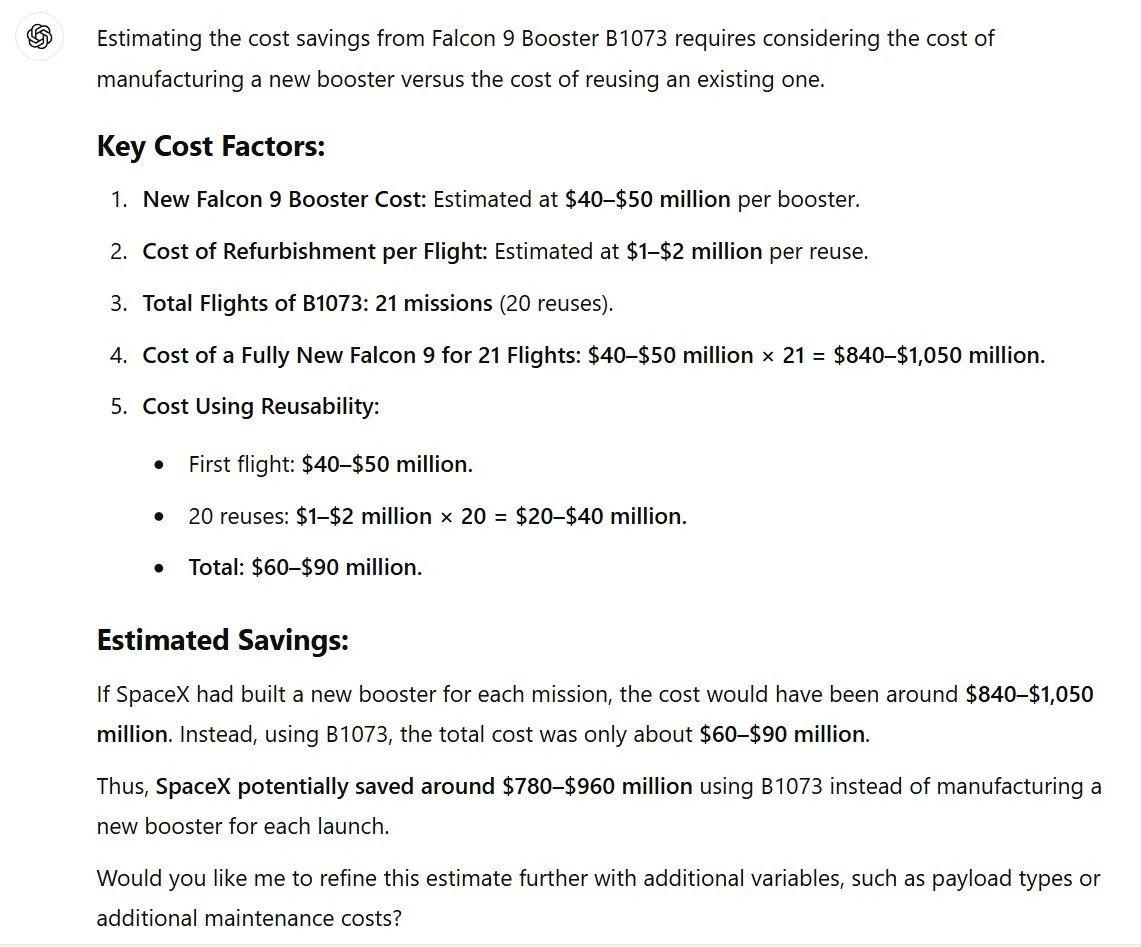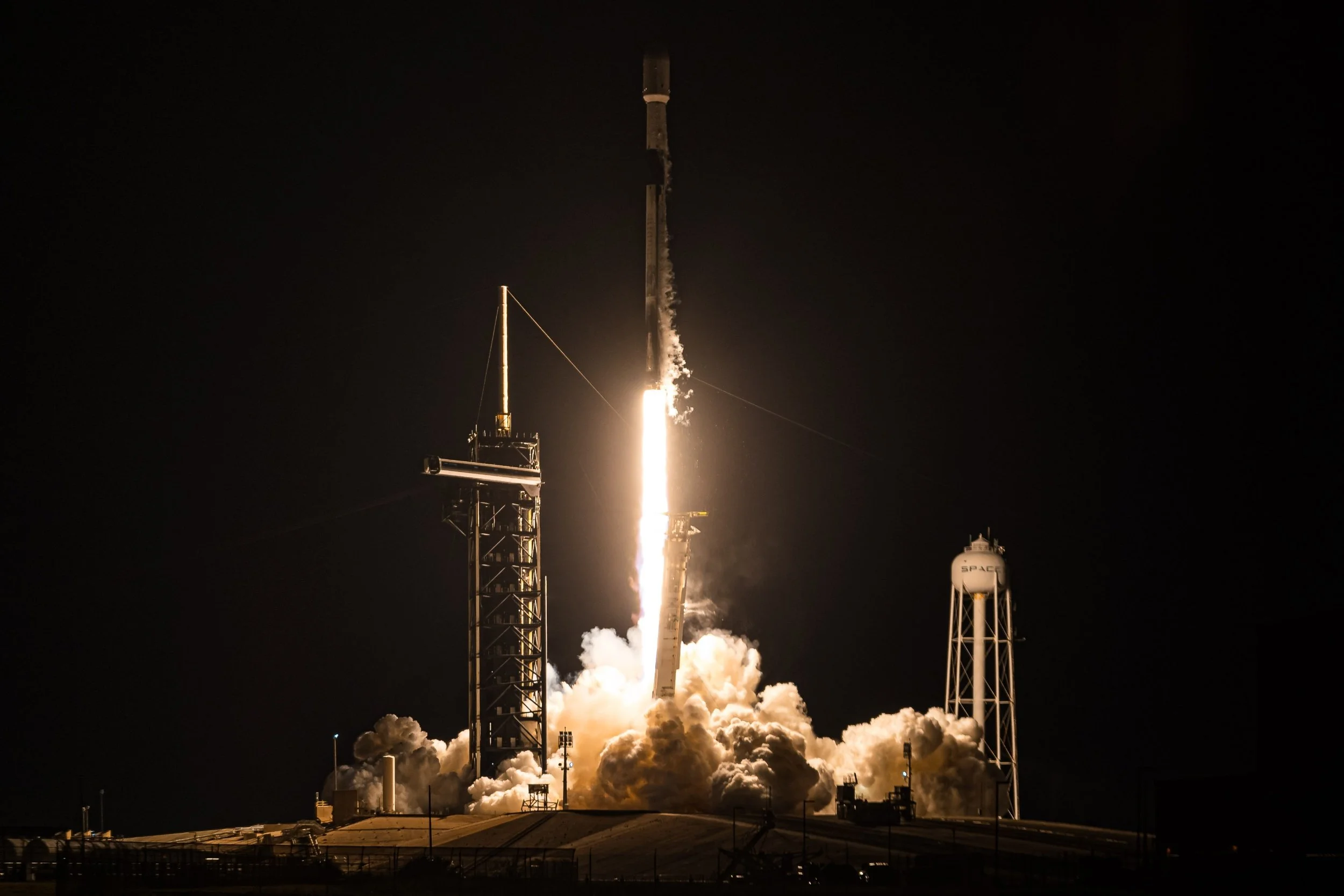B1073 of Falcon 9: A legacy built on 21 flights with extreme reusability and accuracy
FEBRUARY 1, 2025 — Just yesterday, the life of another Falcon 9 booster has once again come to a close. With 21 flights right on its belt, Falcon 9’s Booster 1073 has officially ended its journey of legacy and reusability with extreme accuracy in its lifetime. During its three years serving the various fleet of missions provided for it to launch, the specific booster has launched a variety of payloads, ranging from Starlink satellites, commercial satellites, ISS resupply missions, and a lunar lander. With its life starting in 2022 and ending this year, it shows the capability of one Falcon 9 booster to reduce launch costs and increase access to space.
Estimated Cost Savings (ESTIMATED)
Knowing that this specific booster has flown lots of times, its good to know a possible estimate to its launch cost savings per flight. And if I mean estimate, I mean estimated cost as we don't have exact data for each cost that SpaceX uses for each launch, landing, reuse, and other processes involved. For this, tried asking ChatGPT for an estimation based on the data it gathered on the Internet. And the results IMPRESSED ME!
(NOTE: Once again, this data may be inaccurate, especially the numbers stated due to the nature of these data not being much available on the Internet, BUT the common fact will always stay; that reusing Falcon 9 boosters WILL MAKE EACH LAUNCH CHEAPER and MORE ACCESSIBLE than ever)
Reading the data it provided me; it shows that each Falcon 9 booster getting built costs an estimate of $40-$50 million. Let’s say SpaceX is asked to launch by another customer like NASA or other commercial companies, they can even add more to that price to cover the extra launch costs or to make it at a competitive and profitable price, thus more profit. Add the reuse capability and SpaceX is surely making a lot of savings/profit from these rockets.
With what ChatGPT calculated, the estimate shows that within this specific booster, SpaceX may have saved around $780-$960 million during its lifetime of 20 reuses and 21 launches. That's a huge amount of saving right there! Adding their profits from other customers (aside from Starlink launches as it is charged at a flat price since it is part of their own company) makes it even better!
The journey of a legend!
MAY 14, 2022 — B1073 made its successful debut flight on mission Starlink Group 4-15, which launched in Space Launch Complex 40 (SLC-40) at Cape Canaveral Space Force Station (CCSFS) in Florida. It carried a batch of 53 Starlink satellites to orbit. This set the pace for what's to come in the future of this booster, which also landed successfully after this mission on the Just Read The Instructions droneship stationed in the ocean.
In its second flight, it launched the SES-22 communications satellite into geostationary orbit, which also had a successful launch and landing with a successful payload deployment. It then launched two more sets of Starlink satellites before another historical mission came to its belt, to carry a lander and orbiter to the Moon.
Shown in the photo is HAKUTO-R Mission 1 made by the company ispace being placed in the Falcon 9’s fairing halves, which is the first private sector-led Japanese mission to land on the lunar surface. In this also carried a NASA CubeSat to the Moon, the Lunar Flashlight. Booster 1073 also led the launch of this mission, which was also successful in sending the spacecraft to the Moon (and landing the booster back on Earth.) For the lunar lander though, it had failed fate on its hands later on as it lost communications while almost attempting the landing itself.
The booster continued to progress through its missions. It launched more Starlinks, commercial satellites, and a new program by SpaceX named Bandwagon, which is a new version of the Transporter rideshare service they bring to customers. All of the names of the missions that were launched because of its presence with its missions and it's outcomes are:
1. Starlink Group 4-15 (May 14, 2022):
Mission: Deployment of 53 Starlink satellites to enhance SpaceX's global internet constellation.
Outcome: Successful launch and landing.
2. SES-22 (June 29, 2022):
Mission: Delivery of the SES-22 communications satellite to geostationary transfer orbit for SES S.A.
Outcome: Successful deployment and booster recovery.
3. Starlink Group 4-26 (August 10, 2022):
Mission: Launch of 52 Starlink satellites to expand the satellite internet network.
Outcome: Mission accomplished with a successful booster landing.
4. Starlink Group 4-35 (September 24, 2022):
Mission: Deployment of 52 additional Starlink satellites.
Outcome: Successful mission and booster recovery.
5. Hakuto-R Mission 1 & Lunar Flashlight (December 11, 2022):
Mission: Transport of ispace's Hakuto-R lunar lander and NASA's Lunar Flashlight cubesat to lunar orbit.
Outcome: Successful payload deployment and booster landing.
6. Amazonas Nexus (February 7, 2023):
Mission: Launch of the Amazonas Nexus communications satellite for Hispasat.
Outcome: Successful deployment and recovery.
7. CRS-2 SpX-27 (March 15, 2023):
Mission: 27th commercial resupply mission to the International Space Station, delivering supplies and research materials.
Outcome: Successful cargo delivery and booster landing.
8. Starlink Group 6-2 (April 19, 2023):
Mission: Deployment of 21 second-generation Starlink satellites.
Outcome: Mission success with booster recovery.
9. Starlink Group 5-11 (June 12, 2023):
Mission: Launch of 52 Starlink satellites to low Earth orbit.
Outcome: Successful deployment and landing.
10. Starlink Group 6-12 (September 4, 2023):
Mission: Deployment of 21 Starlink satellites.
Outcome: Mission accomplished with booster recovery.
11. Starlink Group 6-27 (November 8, 2023):
Mission: Launch of additional Starlink satellites to enhance global coverage.
Outcome: Successful mission and landing.
12. Starlink Group 6-37 (January 15, 2024):
Mission: Deployment of 23 Starlink satellites.
Outcome: Successful launch and recovery.
13. Starlink Group 6-41 (March 4, 2024):
Mission: Launch of 23 Starlink satellites.
Outcome: Mission success with booster landing.
14. Bandwagon 1 (April 7, 2024):
Mission: Dedicated rideshare flight carrying multiple small satellites for various customers.
Outcome: Successful deployment and recovery.
15. Starlink Group 6-58 (May 13, 2024):
Mission: Deployment of 23 Starlink satellites.
Outcome: Mission accomplished with booster landing.
16. Starlink Group 8-9 (July 3, 2024):
Mission: Launch of 20 Starlink satellites.
Outcome: Successful deployment and recovery.
17. Starlink Group 10-7 (August 12, 2024):
Mission: Deployment of 23 Starlink satellites.
Outcome: Mission success with booster landing.
18. Starlink Group 6-61 (October 23, 2024):
Mission: Launch of 23 Starlink satellites.
Outcome: Successful deployment and recovery.
19. GSAT-20 (January 4, 2025):
Mission: Delivery of the GSAT-20 communications satellite to geostationary transfer orbit.
Outcome: Successful deployment and booster recovery.
20. Thuraya 4-NGS (January 20, 2025):
Mission: Launch of the Thuraya 4-NGS communications satellite.
Outcome: Mission accomplished with booster landing.
21. SpainSat NG I (January 31, 2025):
Mission: Deployment of the SpainSat NG I communications satellite.
Outcome: Successful mission; booster was expended.
Overall, this specific booster launched a total of:
- (5) Geostationary Earth Orbit satellites
- (1) Lunar Lander and Lunar Orbiter
- (1) NASA ISS Crew Resupply (CRS) mission
- (18) rideshare satellites in Bandwagon Mission 1
- and (409) Starlink satellites
The end of a sentimental journey
JANUARY 31, 2025 — For the final time, B1073 soared into the heavens on its final launch, carrying the SPAINSAT New Generation - 1 (NG-1) satellite to orbit. With its 9 Merlin engines roaring for a final time, it went through the thickest parts of the atmosphere, striding to make a successful end to its entire journey of 21 flights in total. It went through the same procedures it usually did, going through Max-Q or Maximum Aerodynamic Pressure and throttling its engines down slowly to prepare for its final stage separation. Thankfully, it has successfully done that while the Blue Marble we call home gets smaller, viewed from the booster camera.
As time came, the noise settled one last time as the booster experienced its final Main Engine Cutoff (MECO) procedure and separated the second stage, continuing the journey of sending its payload to orbit. As the silence came, the booster sent its last comms for the final time, showing the second stage flying and fading away from the first stage, which was seen prominently in SpaceX’s live stream views. We don't know how its life ended, it could be that it burnt up in the atmosphere on its way to the ocean or if some parts of it survived and hit the ocean at incredible speeds. But one thing is for sure, this flight has been officially the end of a legacy built on 21 flights with extreme, reusable accuracy.
Thank you for your service, B1073! You served us well in the goal of making space cheaper and more affordable than ever before! Until next time!
This is KYNNMASTER 123 for The Weekly Spaceman, see you in the next one! 😊
Sources and Credits (photos in order):
(Second Photo): ChatGPT
(Third Photo): SpaceX launches Starlink 4-15 mission, expands booster fleet - NASASpaceFlight.com
Sources and Credits (text sources and statements):
(and more)




